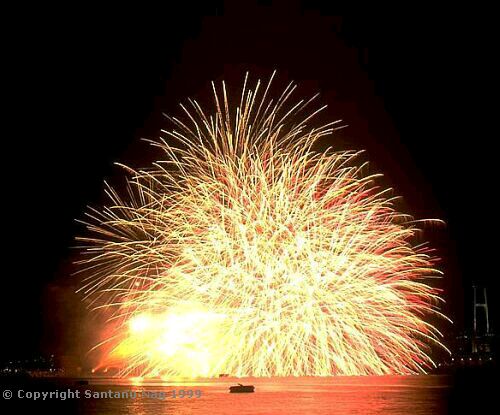
Tips for Firework Photography
by
Santanu Nag © 2000
for
The Spirit Of Photography

Tips for Firework Photography
by
Santanu Nag © 2000
for
The Spirit Of Photography
This brief tutorial will get you jumpstarted started in the art of capturing fireworks.
It will shed some light on the basics of film, exposure, composition
for this special subject. No longer burnt films and blurry photos!
Camera
If you have an SLR (single lens reflex) camera you'll have full control over the exposure settings .. so read on.
Flash
If someone is posing with fireworks in the
background ask him not to move, because u'll have a long exposure timings
to catch the fireworks - and if he moves u'll get a blurry thingy. And With short timings
( 1/125 or lower) there will be no fireworks in ur photo - only a dark background and
a mouthful grin!. Tripod
For fireworks, if you want to
capture the full ascent and the burst, you'll need a exposure timings of typically
0.5s to 8s. Yes that's in seconds. So better drag that darn tripod with you. And
having a cable release also helps to prevent shakes in long exposures.
Lens Film For negatives Kodak Gold 100 and Fuji Velvia/ Sensia II for slides, works best for me.
Exposure
If you want to capture the cracker as it rises
and explodes into dazzles, you have to set a longer time - at least more than 4secs.
Anything lower than 2s usually will get you a part of the fireball not the full blown
one.
Sometimes you might have showers, where the full sky is lit up for quite sometime,
in this case you have to be careful and bring down your exposure to a much lower level.
You can do this by decreasing the aperture size to f16, f22 and so on.
In the climax usually the sky is very busy with too many fireworks, in this situation
a smaller exposure time (1/30s - 1s) usually keeps the photo uncluttered.
Composition General Fireworks can be dangerous, so don't go too near - make your zooms work for you.
Don't finish all your rolls in the beginning, the climaxes at the end are usually
the best.
Try to avoid getting peoples head into your photos.
This event usually gets smokey, don't forget to take care of your equipment.
If you are using a point & shoot, turn off the flash, and set it to the longest exposure
mode it has. Some cameras have nightmode, bulb etc. In the nightmode the camera increases the
exposure time, and in bulb mode the shutter remains open as long as you press the button.
In short turn that damn thing off! You can't light up the full sky. The only exception
is perhaps if you have a subject in the foreground.
Don't even bother shooting without a tripod, it's a waste of film. Of course someone
might find the wavy streaks from handheld camera creative!
Fireworks are generally large subjects! Most of the time I use 28-80mm zoom lens.
The zoom lens gives me more flexibility in composition than fixed lens, especially
when movement is restricted due to darkness and there is not enough time.
Any ISO100 film is good enough - though you might have your own choice of brands.
The main point is you don't need high speed films like ISO400, ISO800 for fireworks.
Firecrackers are very bright, it'll just burn off your high speed film and all your colors
wil be white!. And if you set
it to very small timings (like 1/250), it'll be difficult to capture the full bloom.
Typically fireworks will be streaks of light
against a black sky. I set the aperture at f8 and my exposure timings vary from
2s to 8s depending on the type of burst.
Fireworks work beautifully on a vertical format. Especially if you can include other
lighted structures - like bridges, buildings, cityscapes etc. But then, there are
always exceptions.
If you have water bodies near the venue, reflections can create magic in your photos.
Try to capture the streaks of light as the firecracker goes up in the sky.
To capture multiple bursts on the same frame, you can either go for the
Multiple Exposure mode on modern cameras or leave the shutter open using bulb mode - and
in between fireworks cover ur lens with a hat! Move the camera between exposures so that they
don't overlap on eachother.
Research the site before you go there and try to go to the venue early,
you can then choose your vantage point.
Summary:
|
Home |
Nature |
Wildlife |
Travel |
Links
Works of Nature |
Sign Guestbook |
View Guestbook
Gift Ideas |
Games |
Tips
Recommend this site to a friend:
ADD YOUR SITE|
All images on this site are © Copyrighted
and cannot be reproduced in any form for personal or commercial use
without the written consent of the author of this site.
Please contact
Santanu if you have any queries.You might qualify for royalty-free images. Thank you for understanding. |